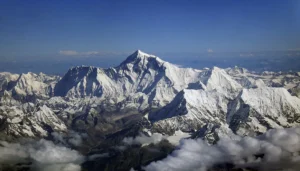The 1,500-mile long Himalayan mountain chain is a land mass pushed upward by the collision of two tectonic plates, the Eurasian and Indian. Its highest point, Mount Everest, was once seabed as shown by marine fossils found near its summit.
But tectonic forces aren’t the only ones pushing the heart of the range higher. Another geological force, isostatic rebound, caused by river erosion eating away the ground below the peaks, is giving the land a springiness that raises surrounding peaks, although at a rate imperceptible to humans.
Scientists liken it to throwing cargo off a ship, which causes the vessel to “float a little higher.” Calculating how much higher is tricky.
If their figure of “up to” 2 mm a year is accurate, then Everest’s top rocks are about 3 inches more above sea level than when Hillary and Tenzing climbed the mountain in 1953, and slightly less than 8 inches higher than when Mallory and Irvine attempted to reach its summit in 1924.
This doesn’t count the snow covering the highest rocks, whose depth varies depending on season and weather conditions.
According to this math, Everest theoretically might be more than 6,500 feet higher a million years from now. But that won’t happen, because the mountain would become too heavy for the earth’s crust to hold it up, and it would sink back into the earth’s mantle (see article here).
For that reason, earth’s highest mountains probably have never been higher than they are now.
Photo below: The Everest massif from the air
